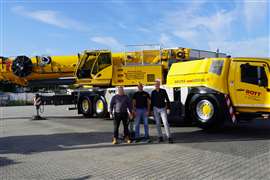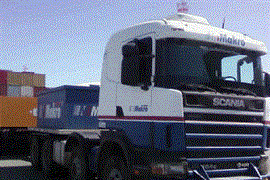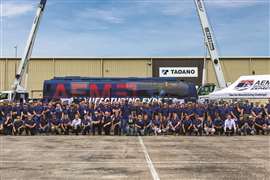What is the market for mega cranes in North America?
28 March 2023
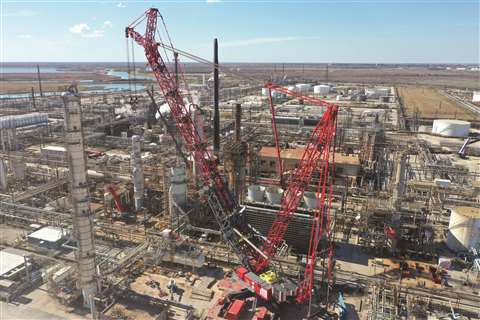 Mammoet’s Focus30 works at a Valero refinery.
Mammoet’s Focus30 works at a Valero refinery.
In the world, there are only five or six cranes that can lift loads that weigh more than 3,000 tons. These cranes are generally one-offs that were developed by regional crane companies because they needed a crane that didn’t exist in the marketplace. The most prominent players in the global mega crane market are Deep South Crane & Rigging, Sarens, Mammoet and Lampson International. All are considered mavericks in the super heavy lift market.
Gavin Kerr, director of global cranes for Mammoet, explained that his company’s entry into the mega crane market is a story with three parts.
“Mammoet first introduced the MSG 50 in 1997, which was the first fully containerized ring crane introduced on the market,” he explained. “This was upgraded to the MSG 80 in 2005, and again in 2009 when the DS boom was added.”
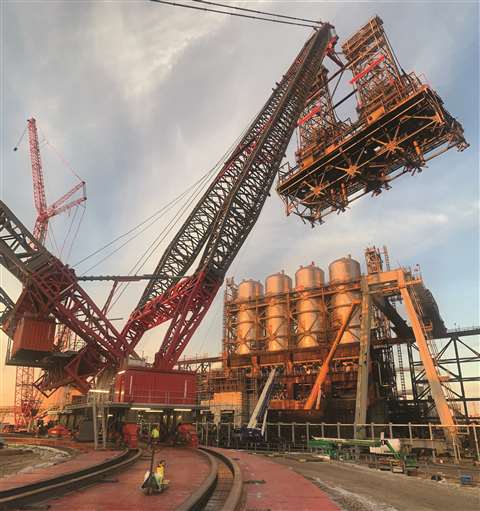 Mammoet’s latest SK series models will unlock a new frontier of design and construction possibilities, the company said.
Mammoet’s latest SK series models will unlock a new frontier of design and construction possibilities, the company said.
Van Seumeren, which acquired Mammoet in 2000, first entered the ring crane market with the CC 4800 twin ring, Kerr said.
“This was a significant increase in lift capacity compared to the crane in its crawler format, and it was the precursor for the PT 50 ring crane developed in 1997,” he said. “The first containerized ring crane by Van Seumeren was the PTC 35, which was introduced in 1999, and like the MSG 80, it too was upgraded to a DS version in 2005.”
Next generation lifters
After the Mammoet acquisition came the new generation PTCs, the 140 DS and 200 DS, in 2011. The 150 DS and 210 DS editions were introduced in 2018 when these rings cranes were upgraded.
“Since 2020, we have been very proud to add the AL.SK cranes to the history of our company,” Kerr said. “The SK 190 was first developed by ALE in 2008 and compared to the other ring cranes where the ballast rotates on the twin ring, the SK rotated around a static and central ballast. This was a true innovation, and it was scaled up in 2013 when the SK 350 was introduced. Since then, the strand jacks have been replaced with winches and a heavy duty fixed-jib has been added. The scale and versality of the super heavy lift cranes offered by Mammoet means we can always deliver the right solution for every problem.”
Mammoet is a big player in this market.
“In the developed world, investment dollars are shifting from expansion to modernization,” Kerr said. “That’s as true for refining as it is steel production. There is a big focus on lowering the carbon footprint of existing operations. Combined with general scheduled maintenance, high capacity cranes with smaller footprints are required for these brownfield projects. This is why we developed the Focus 30, our vertical erecting crane which executed its very first outage in the U.S. in 2022.”
But while increased production capacity in the developing world continues to drive up demand for the larger ring cranes, the biggest growth area will be in offshore wind in 2023, Kerr said.
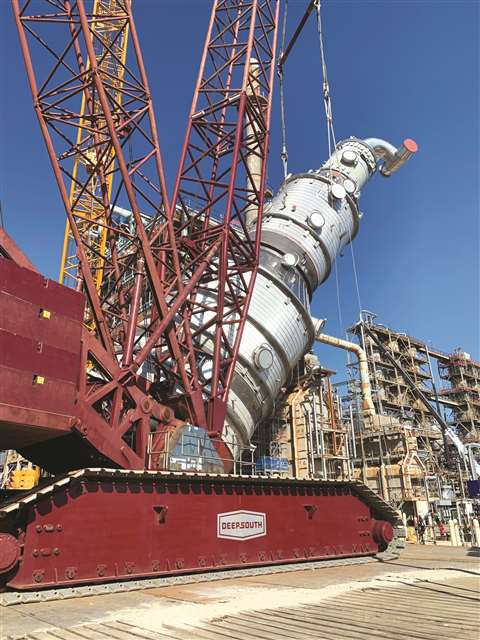 Deep South Crane & Rigging’s VersaCrane installs a Marathon Oil Vacuum Tower.
Deep South Crane & Rigging’s VersaCrane installs a Marathon Oil Vacuum Tower.
“All our new generation PTCs were working in the segment – marshalling jackets, fabricating jackets and integrating turbines,” he said. “This shows no sign of slowing, and we are currently making the final preparations for what will be our first offshore wind project in the U.S.”
Mammoet’s SK 350 recently finished a shutdown in the U.S., and its PTC 210 has completed its final lift in Scotland. Both cranes will be packed up and readied for their next assignment.
“In the U.S., the SK 350 was replacing Coke drums,” Kerr said. “Our ability to lift the 4-drum derrick structure in one complete lift significantly reduced plant downtime. In Europe, our PTC 210 has been loading out jacket foundations on barges. These structures of over 2,000 tons and almost 100 meters tall, will be used to prop up the world’s deepest offshore wind farm.”
In addition to its ring cranes, Mammoet also owns and operates a CC 12600, LR 13000 and Focus 30, all of which are in the 2,000 to 3,000 tons capacity range.
Kerr said there is definitely a supply crunch, and the crane manufacturers are expanding in response.
“But with asset acquisition costs increasing due to inflationary effects on steel, labor and shipping, prices need to increase so that our entire industry retains more value,” he said. “We are almost finished with the detailed design of the SK600, the next evolution of the SK series of cranes. This will unlock a whole new frontier of design and construction possibilities for our customers. We have secured the long lead items and are busy preparing for the structural modifications in between projects.”
Spreading the load
Deep South Crane & Rigging’s Jeremy Landry said the market for its VersaCrane heavy lift crane is highly competitive, with more companies trying to get a piece of the heavy lift crane market.
“Our VersaCranes are presently working across the country,” Landry said. “We have had most of our success lately in the Gulf Coast region, but have also had a few opportunities on the West Coast.”
VersaCranes were specifically designed for tight spaces, he said.
“Most of our work takes place in the industrial sector where tight tail swing fits perfectly in a confined area,” Landry said. “Since the VersaCranes are an outrigger-based crane, it is easy to spread the outrigger load over a large area thus reducing the ground-bearing pressure. Many places on the Gulf Coast have poor soil so a low ground-bearing crane reduces the cost to our clients.”
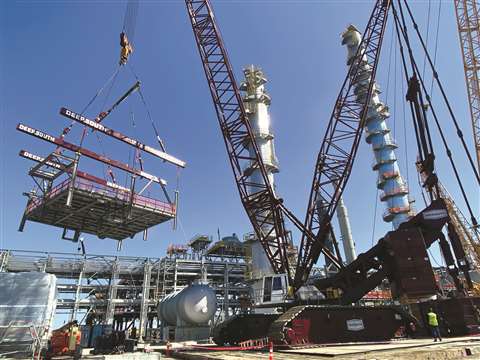 Deep South’s VersaCrane keeps busy along the U.S. Gulf Coast.
Deep South’s VersaCrane keeps busy along the U.S. Gulf Coast.
Deep South also has VersaCrane crawler cranes.
“The CC-9600 (750 tons capacity) and the CC-12000 (1,000 tons capacity) stay equally as busy,” Landry said. “We use special steel ramps in combination with our in-house-manufactured steel mats to reduce the ground bearing pressure for those cranes. We have also several other large Terex crawlers in our fleet.”
VersaCranes compete in all markets where large cranes are required, Landry said.
“New attachments and updates are engineered all the time,” Landry said. “Since Deep South is the sole manufacturer and end-user, we can tailor-make attachments specific for any job. The variable tail swing and special hinge counterweight system allow the crane to be very versatile. The VersaCrane’s hinge counterweight system provides a standout option that allows it to disconnect from the auxiliary counterweights and still maintain a high capacity while decreasing the tail swing.”
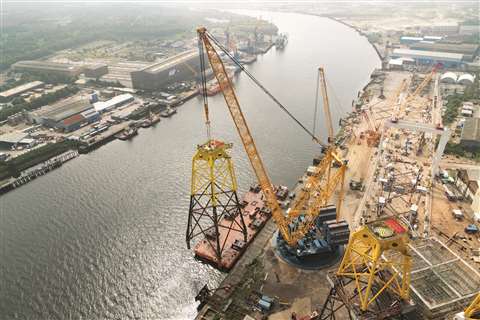 Sarens deploying its SGC-120 for a loadout and assembly operation at the Smulders Projects in Newcastle, United Kingdom.
Sarens deploying its SGC-120 for a loadout and assembly operation at the Smulders Projects in Newcastle, United Kingdom.
Landry said Deep South continues to focus on and improve its VersaCrane fleet and evaluate how to have the best heavy lift tools in the market. In the coming years, Deep South has plans to make VersaCranes even more versatile. Engineering and manufacturing are working to fit every model with crawler tracks, and additional improvements are in the pipeline. “The future and evolution of the VersaCrane line is very exciting and always evolving,” said Landry. “The next project on the horizon might have a special need for a custom attachment, and we are always eager to rise to any challenge.”
Deep South’s history in the mega crane market started with Landry’s grandfather, Camile Landry. In the 1980s, Camile and his son Mitch Landry observed that the market was changing, demanding more cranes with 1,000-ton-plus capacity. They envisioned a crane with a smaller footprint and tighter tail swing that could be easily transported and capable of large capacities. With help from German-born Dieter Juergens, one of the crane industry’s most innovative engineers, they set out to bring this vision to life.
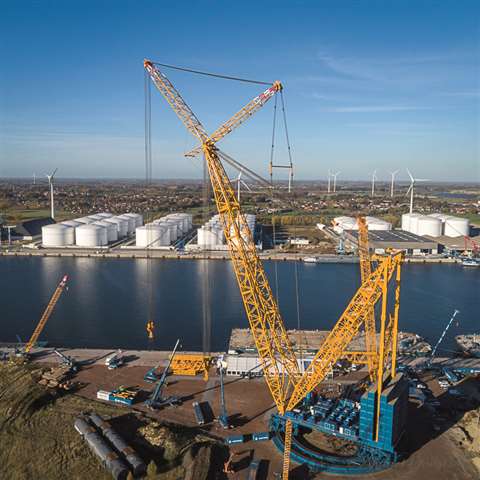 Sarens’ largest crane in Saren’s fleet is the SGC-250, also known as Big Carl.
Sarens’ largest crane in Saren’s fleet is the SGC-250, also known as Big Carl.
The first 1,500-ton VersaCrane TC-24000 emerged in 1993, pairing sheer strength with a patented compact design, allowing it to perform in crowded and congested areas and to travel easily and economically. This single, highly-configurable unit made efficient work of what previously seemed unmanageable – a game-changer for Deep South customers, Landry said.
Growing market
Sarens has developed its own line of mega cranes, known as SGCs which stands for Sarens Giant Cranes. Sarens started producing these cranes in 2011, and today have the SGC 250, SGC 120, the SGC 140 and the SGC 90s, which is the fully electrical and silent crane of its kind.
Lee Rowe, Sarens’ regional director of North America, said they are basically the same type of crane with different capacities.
“There’s a growing market for these cranes in North America,” said Rowe. “Globally, the demand is different from region to region, country to country.”
One big project on the horizon for Sarens in North America is the Intel factory job in Cleveland, OH. Rowe said Sarens will put a Liebherr LR12500 on that job. With a capacity of 2.5 thousand tons, it’s the largest crawler crane in the world, he said.
“We worked with Liebherr on the development of this crane,” Rowe said. “There’s only one of these cranes at the moment and Sarens has purchased it.”
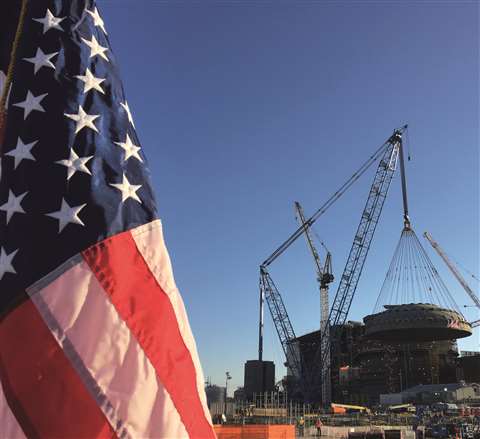 A Lampson Transi-Lift worked on the Alvin W. Vogtle Electric Generating Plant, also known as Plant Vogtle in Waynesboro, GA.
A Lampson Transi-Lift worked on the Alvin W. Vogtle Electric Generating Plant, also known as Plant Vogtle in Waynesboro, GA.“The SGC 250 is still at the nuclear power plant job Hinkley Point in the U.K.,” he said. “It will probably be there a few more years. Our aim is to get one of these cranes in North America.”
Sarens has a large crawler crane fleet of heavy lift cranes in North America, including a CC8800 and four CC6800s.
Lampson International’s Transi-Lift models also compete in this market. With a capacity of 1,000 tons, the first LTL-1000 made its debut in 1978 at the Hanford Nuclear site. The new crane helped to pioneer the “over the top” lifting method. This signature crane brought global notoriety for the company.
The Transi-Lift line includes the LTL-350/500, LTL-1000/1100, LTL-1200, LTL-1500, LTL-2600 and LTL-3000.
STAY CONNECTED


Receive the information you need when you need it through our world-leading magazines, newsletters and daily briefings.
CONNECT WITH THE TEAM









